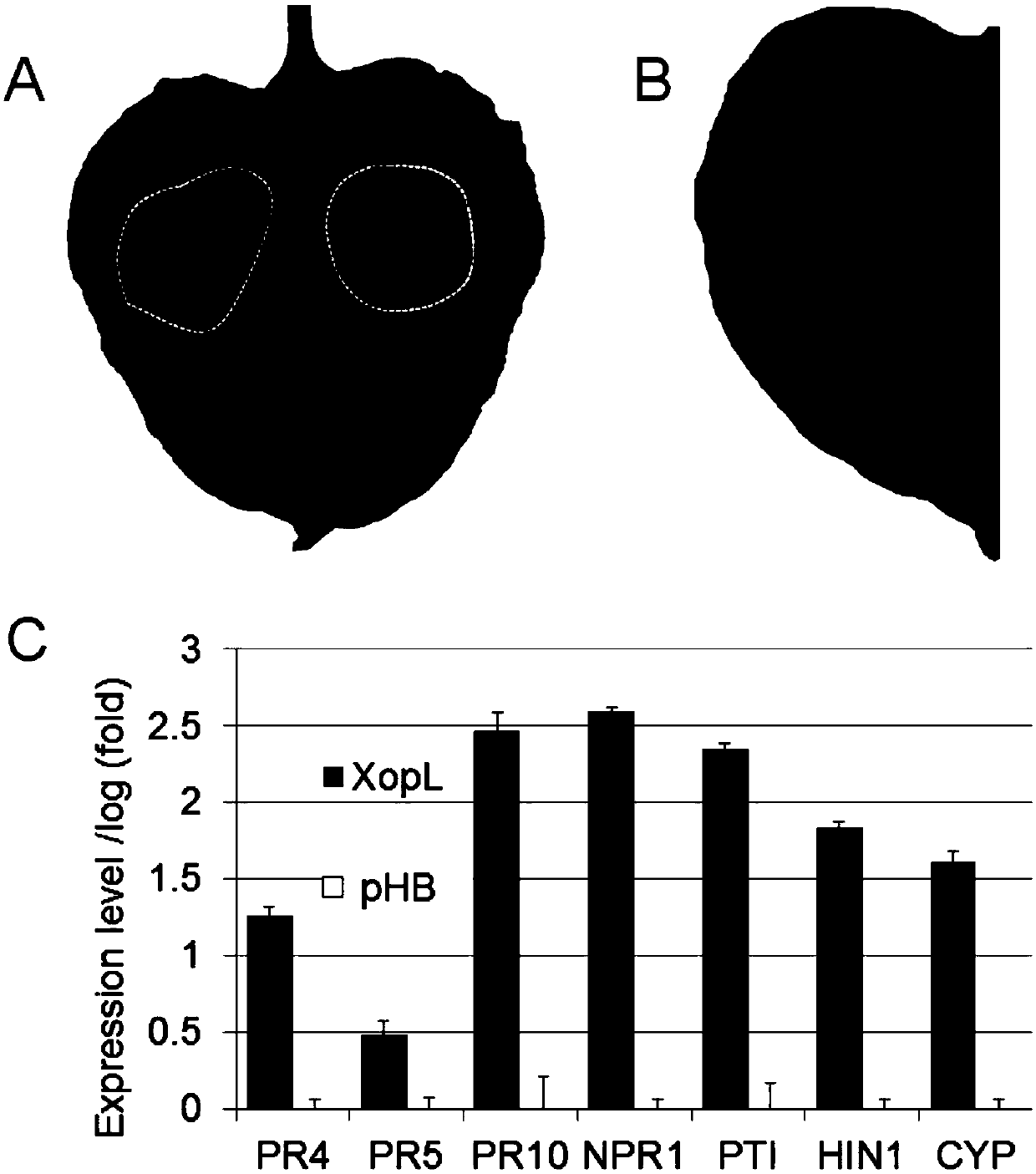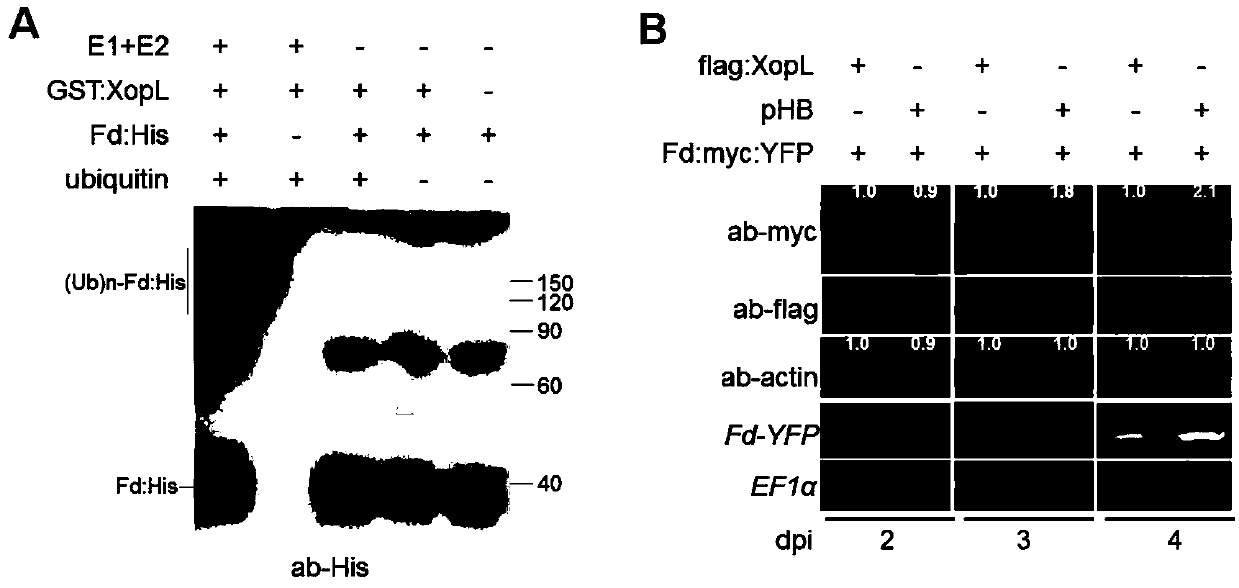Tobacco ferredoxin capable of improving disease resistance of rice and coding gene of tobacco ferredoxin
A technology for encoding genes and disease resistance, applied in the field of tobacco ferredoxin Ferredoxin and its encoding gene NbFd, to achieve the effect of improving bacterial blight resistance
- Summary
- Abstract
- Description
- Claims
- Application Information
AI Technical Summary
Problems solved by technology
Method used
Image
Examples
Embodiment 1
[0035] Cloning and expression of embodiment 1.xopL gene
[0036] (1) Cloning of xopL gene
[0037] Take PXO99 AThe genome is used as a template, and the xopL gene is amplified with primers XopL-F (see SEQ ID NO.4) and XopL-R (see SEQ ID NO.5), cloned into the binary vector pHB using the XbaI site, and the obtained plasmid pHBxopL Transformed into Agrobacterium EHA105 for expression of xopL.
[0038] (2) Agrobacterium-mediated transient expression of xopL
[0039] After the Agrobacterium containing the plasmid pHBxopL was cultured overnight, induction buffer (10 mM MgCl 2 , 0.2mMacetosyringone, 200mM MES, pH 5.6) After washing once, adjust the concentration of bacteria solution OD 600 to 1.0. After standing at room temperature for 1 hour, inject tobacco leaves; inject Agrobacterium containing empty vector pHB as negative control. After 7 days of expression, XopL induced HR responses and cell death in tobacco leaves (see figure 1 A), this process is accompanied by the acc...
Embodiment 2
[0042] Example 2. Interaction between Ferredoxin protein and XopL obtained by yeast two-hybrid
[0043] In this example, the full-length tobacco ferredoxin gene was cloned, and its interaction with XopL was verified by yeast two-hybrid technology. Specifically: XopL was used as a bait to screen interaction factors from a tobacco cDNA library, and it was confirmed by sequencing that the positive clone contained the gene encoding Ferredoxin protein. The Ferredoxin gene was amplified in tobacco cDNA with primers Fd-F (SEQ ID NO. 6) and Fd-R (SEQ ID NO. 7). The PCR product was digested with NdeI and EcoRI and ligated into the pGBKT7 vector to obtain pGBKT7-Fd. After co-transforming yeast AH109 with the pGADT7-xopL plasmid expressing xopL, double hybridization was performed to confirm the interaction between Ferredoxin protein and XopL (see figure 2 A).
Embodiment 3
[0044] Example 3. Verification of the interaction domain between XopL and Ferredoxin
[0045] In this example, mutants of XopL and Ferrdoxin proteins were constructed by truncation, and the interaction domains of the two proteins were further verified. Specifically, the N-terminal (1-452aa) domain XopL-N of XopL is amplified with primers XopL-F (SEQ ID NO.4) and XopL-N-R (SEQ ID NO.8); primer XopL-C-F (SEQ ID NO.9) and XopL-R (SEQ ID NO.5) amplify the C-terminus (453-656aa) of XopL, namely XopL-C. The PCR products of each mutant of XopL were cloned into pGADT7 vector respectively. The C-terminal (51-144aa) of Ferredoxin was amplified with primers Fd-C-F (SEQ ID NO.10) and Fd-R (SEQ ID NO.7), and cloned into pGBKT7 vector. Yeast two-hybrid results proved that both the N-terminal and C-terminal of XopL interact with Ferredoxin protein, and the C-terminal of Ferredoxin protein still interacts with XopL (see figure 2 B).
PUM
 Login to View More
Login to View More Abstract
Description
Claims
Application Information
 Login to View More
Login to View More - R&D
- Intellectual Property
- Life Sciences
- Materials
- Tech Scout
- Unparalleled Data Quality
- Higher Quality Content
- 60% Fewer Hallucinations
Browse by: Latest US Patents, China's latest patents, Technical Efficacy Thesaurus, Application Domain, Technology Topic, Popular Technical Reports.
© 2025 PatSnap. All rights reserved.Legal|Privacy policy|Modern Slavery Act Transparency Statement|Sitemap|About US| Contact US: help@patsnap.com



